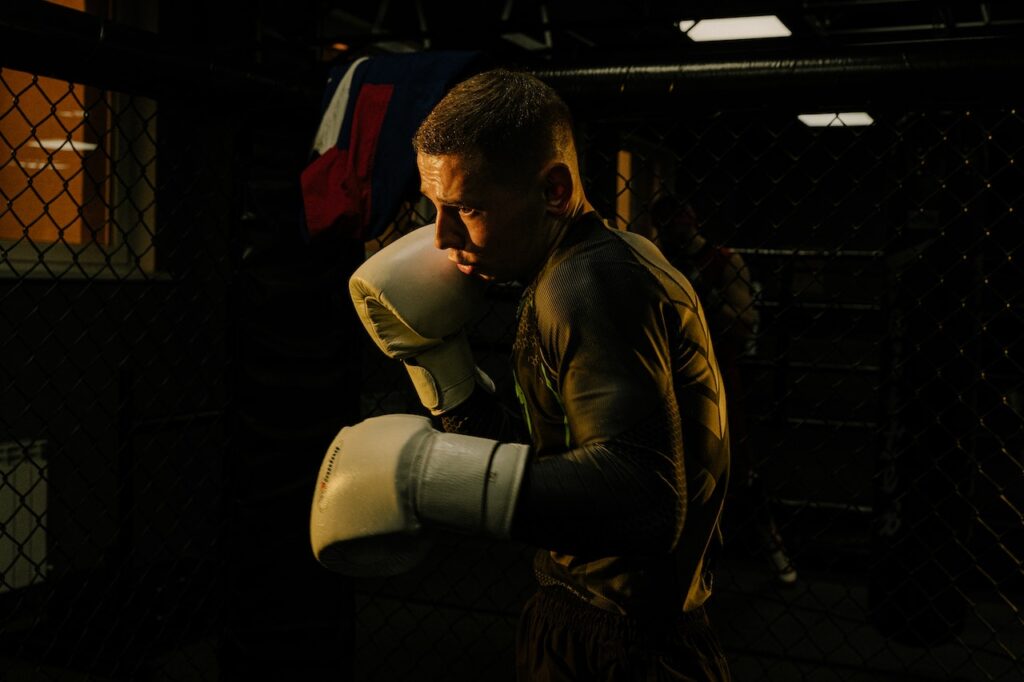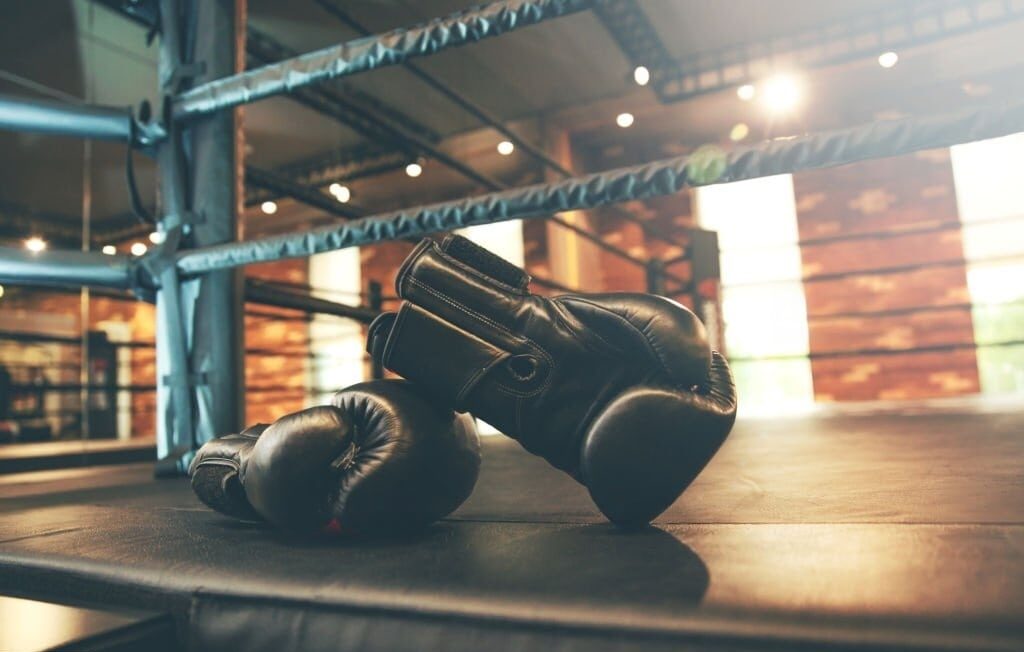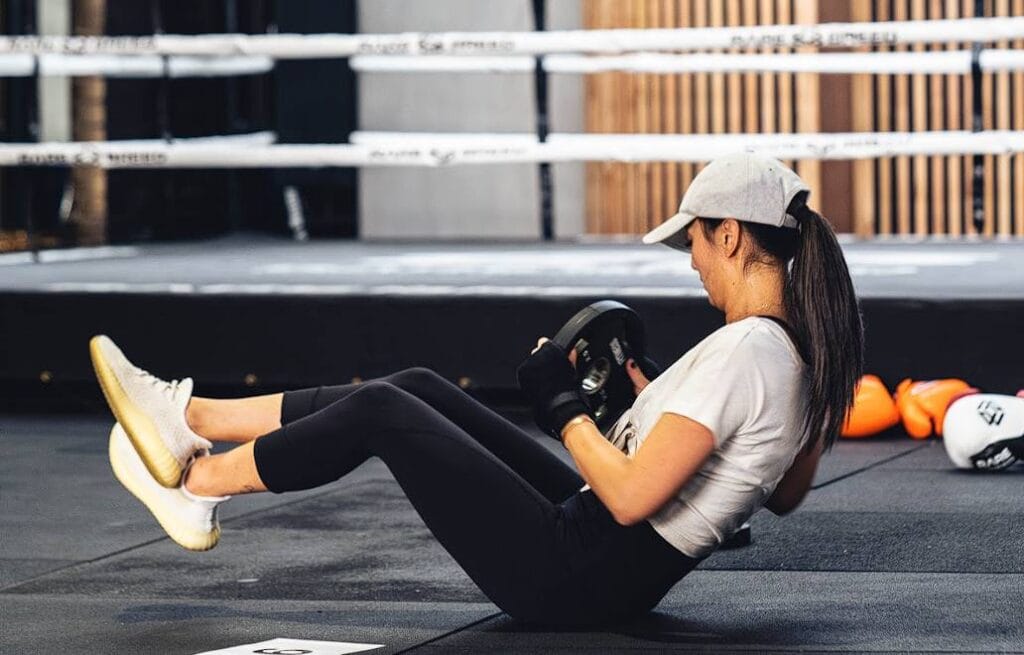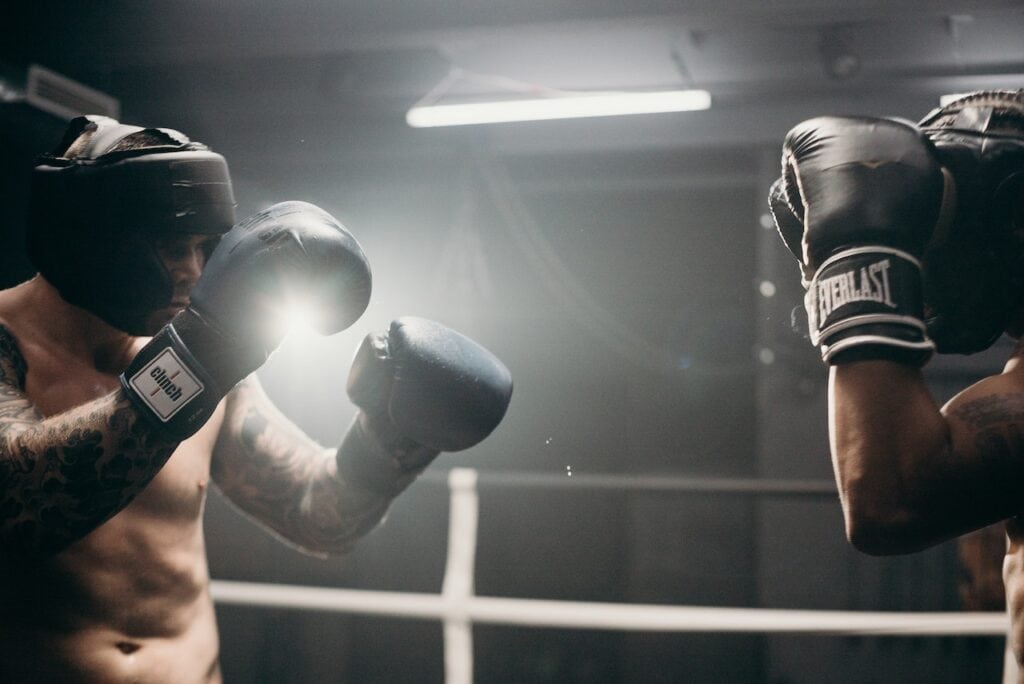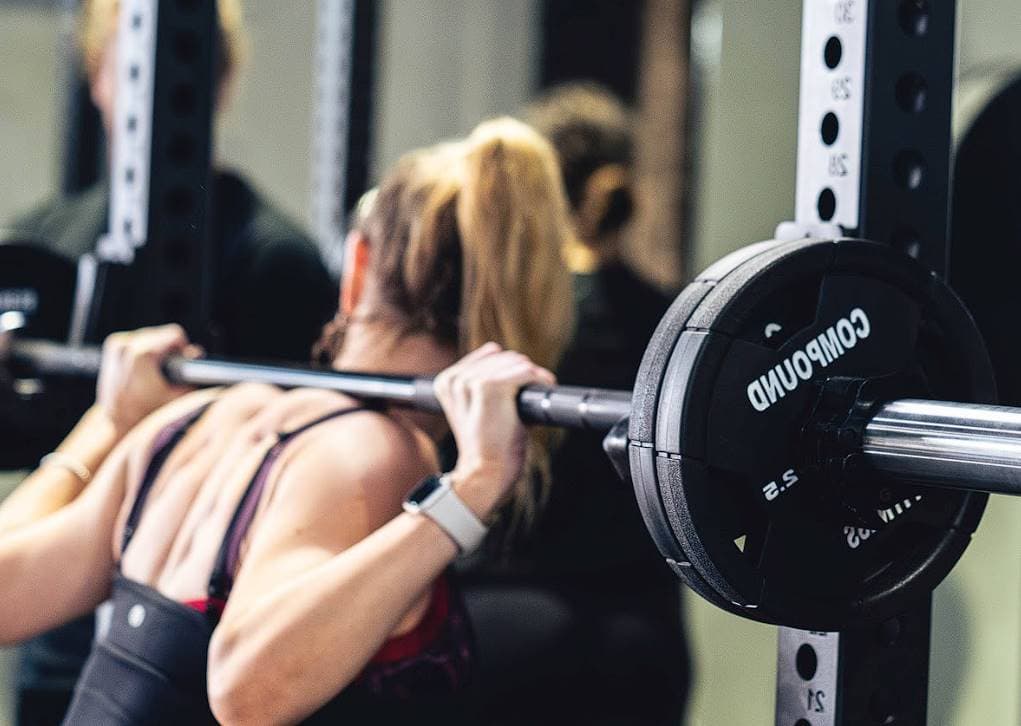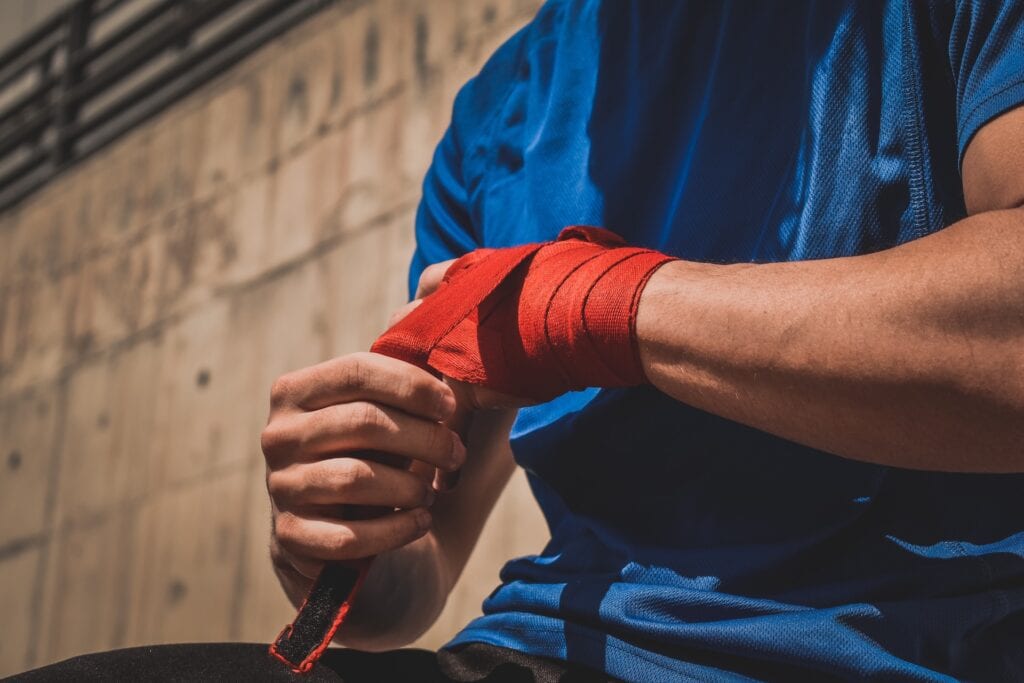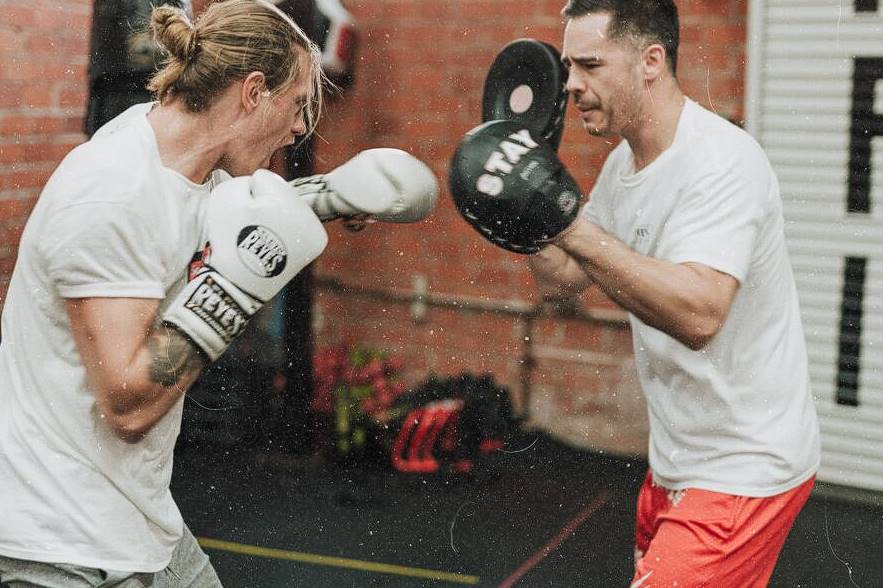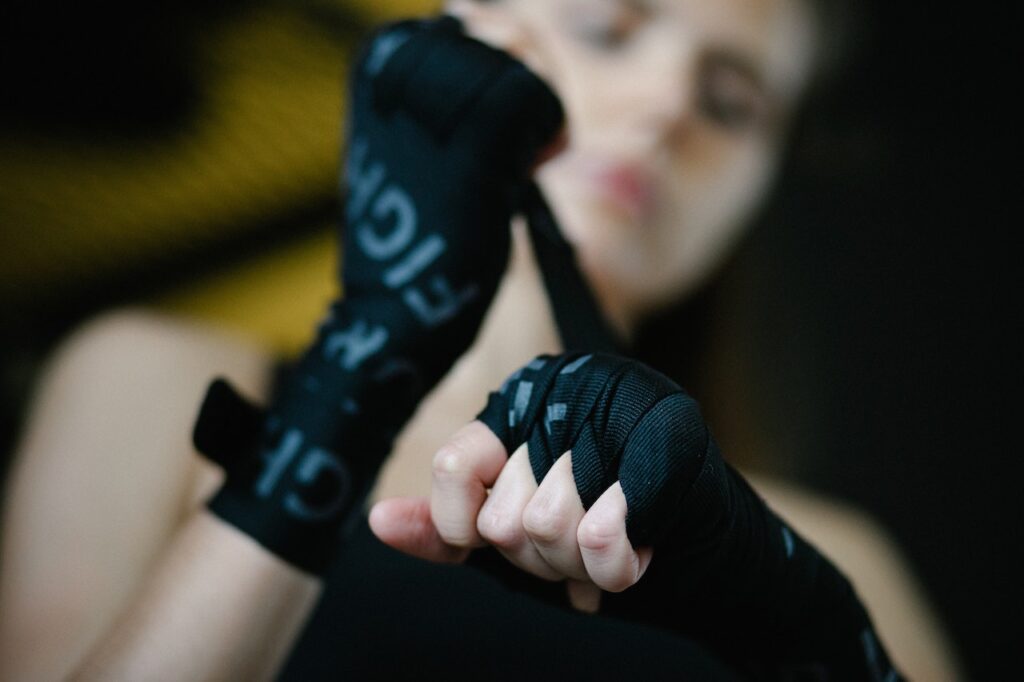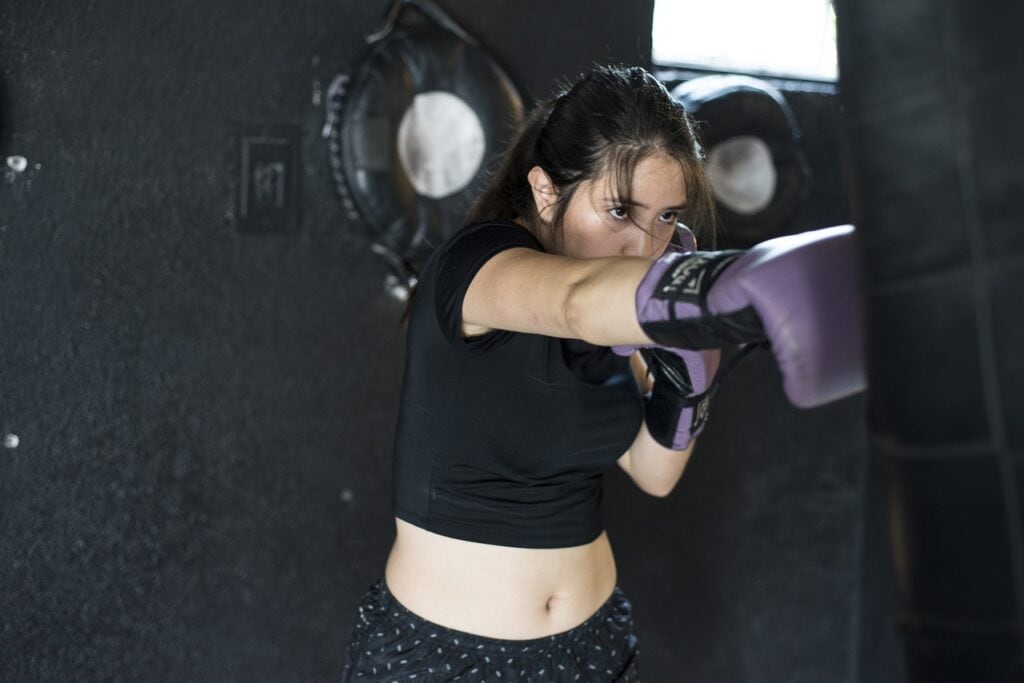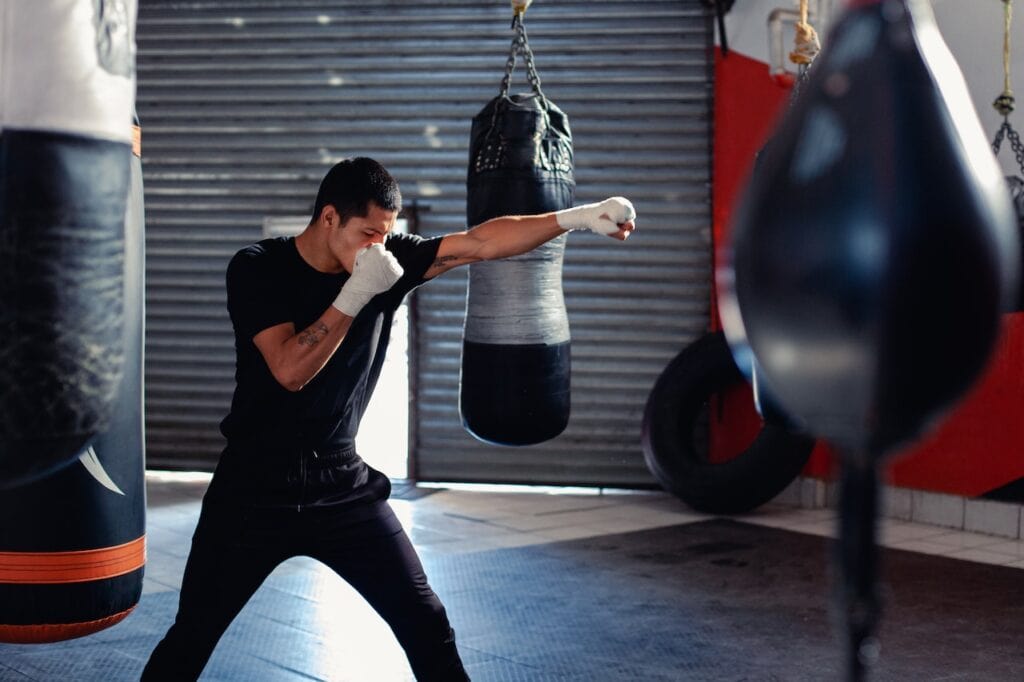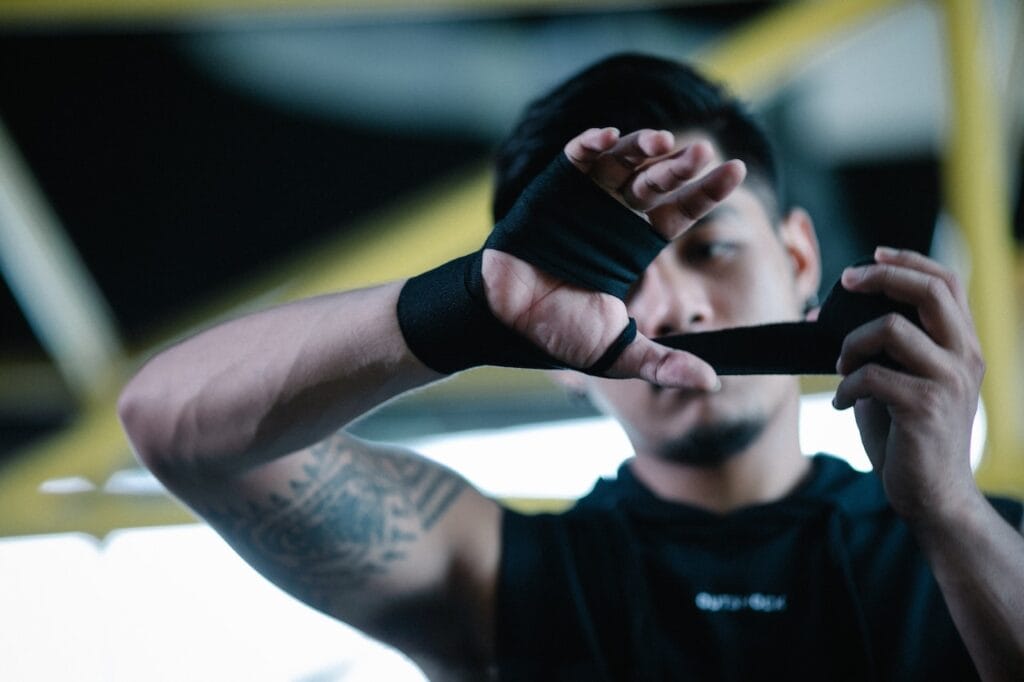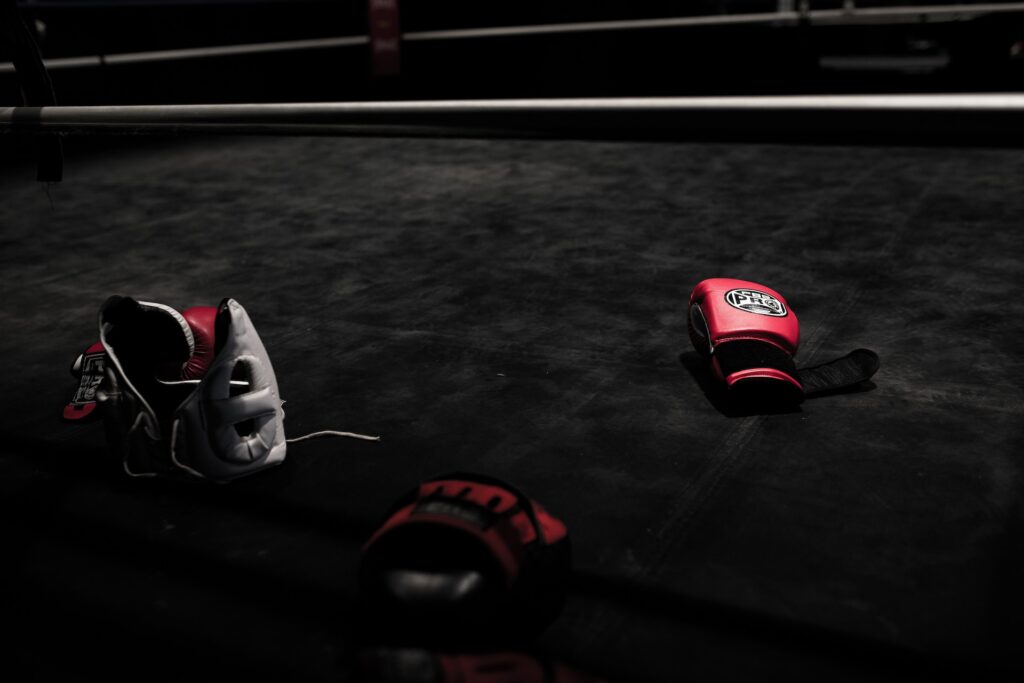Boxing is the ideal kind of cardiovascular exercise. This one-of-a-kind workout improves your strength and cardiovascular fitness and teaches you an important life skill while you push yourself to your physical and mental limits.
Another significant benefit is that you can study boxing in your own house.
You got that right. You can teach yourself how to box at home, and this post will provide you with all the information required to become a self-taught boxer.
We might come up with many excuses as to why we can't go to the gym, but the most common is that we don't have enough time. Despite this, you shouldn't let the fact that you can't go to the gym prevent you from learning how to box.
Boxing is a sport that can be done practically anywhere as long as you have the essential gear, which includes boxing gloves and a heavy bag.
It is one of the sport's most appealing aspects. Boxing for beginners can seem difficult to master, but learning how to study boxing at home can be accomplished with just the fundamentals and a few basic pieces of equipment.
HOW CAN A BEGINNER START BOXING AT HOME?
HOW DO YOU DO BOXERCISE AT HOME?
Exercising doesn't have to be a difficult activity to perform. You can perform boxercise in the comfort of your own home by performing basic boxing motions such as:
- Jumping rope
- Exercises involving shadowboxing
- Heavy bag drills
- The essential duties
Boxing is a sport that benefits greatly from the practice of jumping rope since it improves concentration, speed, agility, and cardiovascular endurance. You can begin skipping rope for two minutes as a warm-up or do it for five to ten minutes for an additional aerobic boost.
Because you don't need boxing equipment to practice shadowboxing drills, you can do them anywhere. It makes them quite convenient.
You can practice perfecting your form, posture, and punches when you shadowbox because you can play out many scenarios that can occur while facing an opponent. Shadowboxing can help you polish your form. Y
ou can begin with a jab or a cross drill or practice your defensive maneuvers like slipping, which involves slightly bending your knees, bringing your hands up to shield your face, and moving your head slightly to the side.
Power can be gained through the use of heavy-bag drills. For example, you can perform a straightforward exercise by throwing a pair of quick jabs, resetting, and then throwing two more quick punches for three minutes.
Boxers need to have a solid abdominal foundation even though you are constantly activating your core when boxing, you may still do additional core work by performing exercises such as sit-ups, flutter kicks, elbow plank (push-up posture on your elbows), high plank, etc.
HOW CAN A BEGINNER START BOXING AT HOME?
If you are starting in boxing, the first thing you need do is familiarise yourself with the sport's fundamentals, which are as follows:
Stance
Punches (jab, cross, lead hook, rear hook, lead uppercut, and rear uppercut) (jab, cross, lead hook, rear hook, lead uppercut, and rear uppercut)
BOXING STANCE
Your stance is incredibly significant because, if you are not employing the correct form, you risk losing your balance, reducing your blows' effectiveness. Imagine that your feet are parallel to one another and on opposite sides of an imaginary line to assume the boxer's stance.
Your weight is distributed uniformly over your body. You attempt to shield your face with both hands, and your chin is tucked in just a little bit. Your back arm will become your dominant arm over time.
PUNCHES
The jab, the cross, the lead hook, the rear hook, the lead uppercut, and the rear uppercut are the most popular punches.
Jab
In boxing, the jab is considered to be the most crucial punch. Its purpose is to build up further blows and throw off your opponent's rhythm. Starting from your combat stance (hands up, elbows in, gazing between your eyebrows), elevate the lead foot ever-so-slightly to initiate the jab.
When the weight begins to fall back down, you should immediately extend the lead hand fist directly in front of you. Make sure that your knuckles are turned inward so that the palm of your hand is facing the ground.
Cross
Your backhand should be thrown from your chin, causing it to cut across your body as it travels directly toward the goal from where you are positioned. When the arm crosses the body, the shoulders should rotate 180 degrees, with the knuckles of the rear fist moving inwards upon extension.
At the same moment, the hand that is leading is brought back and tucked against the face to shield the chin. As you throw the cross, rotating your torso and hips will help you generate greater power.
Lead Hook
When you are in a fighting posture, you should first shift your weight from your front foot to your back foot.
While the weight is being transferred, the shoulders should rotate towards the opposite rear side, and the elbow should be lifted to a 90-degree angle while the target is being aimed. At the blow's very end, the lead position's foot should pivot and spin to maximise power.
Rear Hook
When you are in your fighting posture, you should start the rear hook by pivoting your weight off the ball of your rear foot.
When this occurs, the weight should be transferred to the lead side, and the hook elbow should be lifted to a 90-degree angle as the target is aimed. At the very finish of the punch, the back foot should pivot and spin in conjunction with the hook to generate the most power.
Lead Uppercut
After assuming the boxer's battle stance, move your weight to the leg that will be your lead. Next, you should quickly and sharply push your arm out so that the back of your hand is towards your opponent and the knuckles are facing up.
Next, turn your hips inward and pivot on the foot that is currently leading. Be sure to keep your backhand raised so that you may shield your face with it.
Rear Uppercut
Throw your rear side hip forward while simultaneously pulling your arm out and up to the point where your palm is facing you. Do this while maintaining your battle posture. Always remember to keep your dominant hand raised to shield your face.
Advantages of learning boxing at home
Unbeatable Workout
One of the most severe forms of exercise is boxing training. Period. I dare you to discover any activity that will test your physical and mental capabilities to the same extent as boxing.
People who consistently train in boxing are rewarded with excellent cardiovascular health, an incredible physique, and a level of self-confidence through the roof. But, unfortunately, these benefits come at the cost of some discomfort. What other type of competition achieves these kinds of results?
Workouts that involve boxing are also quite productive. If you wanted to burn the same number of calories as you would in thirty minutes punching heavy bags, it would take you many hours of running. So it is perfect for folks who have limited time to train but still want to get the most out of their workouts.
Boxing is another hard form of exercise that can be done. You will only be challenged further as you get fitter, and the routines will always be simpler. You are continuously challenged beyond your capabilities, which not only makes the workouts fun but also helps you maintain your motivation over time.
Flexibility
Learning to box at home allows you to train around the challenges that life throws at you. In addition, you can train whenever you want, giving you the flexibility and convenience that comes with that.
No longer can you use the excuse that you do not have enough time. Everyone can carve out at least twenty minutes per day for a session on the punching bag. If you cannot, you are not putting boxing high on your list of priorities.
Boxing at home allows you to create a workout plan that coordinates with your already established routine. You do not have to give up your favourite television show, your social life, or the time you spend with your children to lose weight.
To become proficient in boxing, you need just set aside 20–30 minutes every day, or even more, time, if you have it, to practice the sport.
You will still have plenty of time for all your other responsibilities, and because your routine won't be disrupted, you will have a greater chance of developing a habit that will stick with you for the long run.
Makes Boxing Gyms Less Intimidating
Being a novice at something and jumping into a group where everyone else is more experienced than you might be scary. This event can be extremely nerve-wracking, especially if the club you're signing up for is only going to battle for fun.
Before joining a boxing club, it's a good idea to get some practice at home by first understanding the sport's fundamentals. Then, you'll be able to hit the ground running with the crucial foundational knowledge you've gained as well as a good base level of fitness.
Suppose you are already in relatively excellent shape and have some knowledge of boxing. In that case, you may have the self-assurance necessary to begin training at the boxing gym in your area.
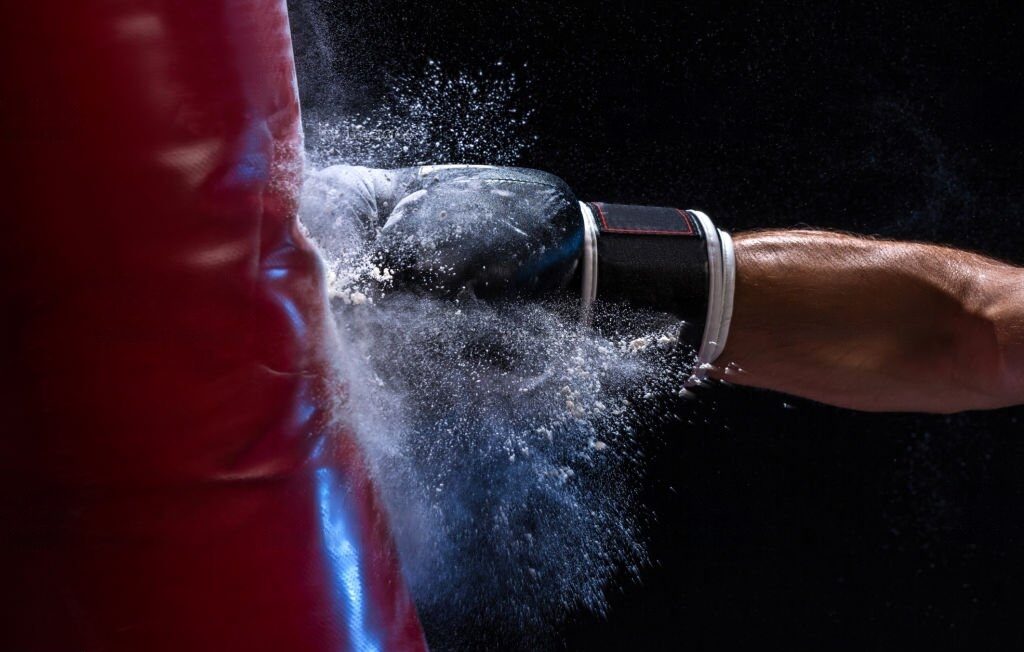
Disadvantages of boxing at home
There is no perfect option, and learning to box at home comes with challenges. The education received at home is not adequate for the following four reasons:
Training Solo
Outside of a dedicated workout environment, it can be difficult for many people to find a training partner. As a result, working out alone may be a frustrating and, at times, even boring experience.
If you do not have a training partner, your workouts will consist of road work, skipping, exercises, and hitting the bag.
It also means that you won't be able to participate in mitt work, which is beneficial for enhancing hand-eye coordination and allows you to practice striking a moving target. Sparring, another essential component of your training, will also be out of the question.
No Sparring
Your talents will never be tested in a real-world conflict if you don't spar.
Even though you may be able to make the heavy bag cry for mercy, I'm betting that your boxing talents would be ineffective for self-defence if you didn't get the first punch in. It is assuming, of course, that you didn't throw the first punch.
Your boxing arsenal will only be complete with the fundamental dodging, blocking, and countering skills.
Lack of Motivation
One more significant disadvantage of training at home is that it can be difficult to maintain motivation. It is only natural for our desire to wane if we are not faced with new challenges and do not have the impression that we are making progress.
You might start with a lot of enthusiasm, but after a week, a month, or a year of training by yourself, you can realise that your sessions are getting shorter, there are fewer of them, and they are getting further between.
No Coach
Because you need access to an experienced trainer, you must educate yourself on the perfect form. When you are your instructor, picking up undesirable behaviours that may take several months to unlearn is quite simple.
Fortunately, there is a workable remedy to this remaining disadvantage, which will be discussed in more detail below.
HOW TO BOX AT HOME - 5 BASIC TECHNIQUES
WHAT ARE THE BASIC BOXING TECHNIQUES I CAN LEARN AT HOME TO GET IN SHAPE?
The fundamentals of boxing, including basic punches, combos, and exercises, can be learned at home by individuals just starting the sport. However, if you're interested in boxing but need help knowing where to start, we'll show you how to learn the skills you'll need immediately.
WHAT ARE THE BASIC SKILLS OF BOXING?
Boxing novices should become familiar with the boxer's stance, the jab, the cross, the hook, and the uppercut strikes before moving on to more advanced techniques.
Successful boxers can use a combination of deft footwork and accurate punches, all while maintaining tight coordination with one another. Anybody interested in improving their fitness level can master the art of boxing by first becoming proficient in the fundamental techniques described in this article.
WHAT IS THE CORRECT BOXING STANCE?
To begin developing the correct boxer's stance, you should:
- Always lead with the shoulder that is diagonal across from your punching hand (Right-handed boxers should position their left shoulder toward the target and vice-versa)
- The distance between the feet should equal the breadth of the shoulders.
- Put your feet at a 45-degree angle towards the direction of the target you want to hit.
- Maintain a small bend in both your knees and hips.
- Protect your chest by bringing your elbows close to your sides and using your forearms as a shield.
- Maintain the glove at the level of your shoulders.
- Place the right glove beneath the chin with the palm facing outward and the wrist turned inward.
Footwork and stance are essential components of boxing that novices must master before they can successfully establish and develop their boxing talents.
WHAT ARE THE BASIC BOXING PUNCHES?
Boxing is built on a base of four primary punches: the jab, the cross, the hook, and the uppercut.
The Jab is a short, sharp punch that is delivered by the arm that is going forward. Boxers who punch with their right-hand jab with their left arm and vice versa.
The Cross is a punch delivered in a straight line with the back arm. Boxers who punch with their right-hand punch with their right arm, and vice versa.
The Hook is a short side punch delivered at a right angle to the opponent. These are the kinds of blows that can be delivered with either arm.
The Uppercut is a quick punch delivered vertically upward to the body with either arm.
It is not necessary to have access to a gym to master the boxing methods necessary for beginners. However, while you are waiting to build more sophisticated boxing technique combos, you should learn the greatest boxing methods at home.
How to Start Boxing at Home With No Equipment
Start With Shadow Boxing
A training method known as "shadow boxing" refers to boxing without equipment or an actual opponent (essentially, punching the air).
However, you will need to ensure that you have sufficient space to move around, and you might find it helpful to practice in front of a mirror to alter your form.
Experiment with throwing different punches, producing different kinds of combination movements, and combining different defensive boxing methods.
Try out an application like Aaptiv if you are just starting and could use a little direction. These tools teach you fundamental boxing fundamentals and even provide shadowboxing sessions to help you improve your game.
You will become a much better boxer if you consistently work to improve your ability to make adjustments on the fly through practice.
1. Stance
Your stance is something to keep in mind as you progress through your shadowboxing practice. Your foot that is not your dominant one should always be in front of the other one.
According to the manual published by USA Boxing, a right-handed boxer should lead with their left foot while placing their right foot at the 3 o'clock position, which is behind their left foot and slightly to the side. It should be done while ensuring that their feet are shoulder-width apart.
Your lead hand (which is your left hand if you are right-handed) should be positioned such that it is roughly at eye level, and your rear arm should be tucked close to the body, almost touching your ribs. Always keep your back arm in a guard position, with your elbow tucked and your arm beneath your cheekbone to protect your face.
It's best to avoid standing with your feet too far apart or too close together because this can affect your speed and balance.
To feel anchored in the floor, enough weight should be distributed between the feet, and the knees should be bent ever-so-slightly. You are not going to fall even if someone pushes you. You have balance. People often need more width or height.
2. Footwork
The boxing technique relies heavily on footwork, so doing it right is essential. To begin, you should anticipate that your steps will be more of a shuffle. It is because the foot closest to the direction in which the person wants to walk is the foot that steps first.
While you step, your feet should remain shoulder-width apart and in the same 45-degree stance as specified in the previous sentence.
It is important to avoid crossing your legs or feet because doing so can lead you to lose your balance, which leaves you open to attack from your rival. Instead, maintain your balance by standing on your feet' balls and ensure that your weight is distributed evenly between both legs.
Because your feet never leave the boxing stance, the footwork may at first appear to be tough and paradoxical. Please continue to practice it until it becomes automatic for you.
3. Punches
The jab, the cross, the hook, and the uppercut are the four fundamental sorts of punches. Depending on the overall strategy, these individual blows can be combined in various ways. As you develop combinations, think about how you will logically distribute your weight and strength.
For instance, if you throw a jab, the next logical punch you could throw is likely a cross. On the other hand, if you follow a left hook with a jab, it could knock you off your balance because your weight isn't spread equally at that point.
Remember to guard with the hand that is not throwing punches while you are throwing them. Maintaining your guard during practice sessions can help you develop the habit of doing so automatically.
According to Young, boxers' power comes from their complete bodies, not just their arms. Everything revolves around your core, but you must rotate your hips while engaging your abs, legs, and other core muscles. So put every resource to good use!
- Jab: The jab is the first step in the chain of fundamental strikes. First, you thrust forward with your dominant hand (your non-dominant side). A straight punch is also known as a jab, consisting of punching straight out and back. Next, your hips rotate slightly to the side you are leading with, and your body weight moves over to the leg in the lead position.
- Cross: The cross is a straight punch delivered with the power hand, the rear hand. As you rotate your body to the front by pivoting your back foot and moving your body forward, your weight will move to the leg in front of you.
- Hooks: Hooks are often employed to catch targets located at a medium distance. When you throw a hook, your arm should make a 90-degree angle with the side of your body and come out somewhat to the side of your body. When you use a lead arm hook, a small portion of your body rotates to the lead side, shifting your weight to the lead leg. Your torso will move ever-so-slightly to the rear side as you throw a rear arm hook, but you will keep your weight on the leg in front of you.
- Uppercut: The uppercut is a punch that hits opponents at close and medium range. To prevent getting hit in the face while throwing a lead arm uppercut, gently bend your knees and drop your back shoulder. Keep your elbows bent as you bring your lead arm up to meet your opponent's chin and drive it there. Your rear arm should remain rigidly in the guard position for the entire duration. You should keep your shoulders drawn down your back rather than up to your ears.
4. Defense
Work on developing some fundamental defensive maneuvers from your boxing stance to avoid getting struck while you're in the ring.
Even if some of the defensive moves require you to cover your body and face, you must ensure that you never stop keeping an eye on your opponent while you are practising the various defensive moves.
- The bob is performed by squatting down and then immediately standing back up. Imagine having to duck down to escape being hit by a punch headed your way. Keep your eyes on the target, and your chin tucked in while you guard your body with your arms.
- Slips: To make a slip, you must tilt your upper body to the left or the right. Keep your arms in a guard position while bending your knees ever-so-slightly to allow your body more range of motion.
- Bob and weave: A bob and weave positions you to hit your opponent and consists of stooping down and walking to the left or right before standing back up. It allows you to set yourself up for a more effective strike. Keep your arms raised to guard your face and ribs if you get punched.
This At-Home Boxing Workout for Beginners Will Get You into Fighting Shape
At-Home Boxing Workout for Beginners
How it works: After warming up with jump rope, you'll perform each round of this boxing workout at home with as little or as much rest as possible between the rounds.
You will begin with a boxing combo and then transition into a strength move. Three more times around the whole circuit, which includes all four combos.
You'll need a jump rope.
Warm-Up: Jump Rope
This classic boxer's warm-up will get your heart rate up and your muscles loose. If you have access to a real jump rope, by all means, make use of it; if not, pretend that you are holding one in your hands.
- A. Start by standing with your feet hip-width apart and grasping one handle of a jump rope in each hand. Your elbows should be tucked down tight to your ribs, and your arms should be by your sides.
- B. Bring the jump rope up and over your head to get started. Perform as many rapid jumps as possible while bouncing lightly on the balls of your feet in between each one. Always keep your shoulder blades down and back, and use your wrists, not your arms, to rotate the rope.
For the next three to five minutes, jump rope.
Round 1 Combo: Jab, Cross, Jab, Bob and Weave
- A. Start in a standing stance with your left foot forward and your arms in a "guard" position (elbows bent, hands in fists on either side of chin). It would help if you began by throwing a left jab, which consists of quickly punching the left arm forward while rotating the fist down and without locking out the elbow. After that, you should throw a right cross, which consists of punching the right arm forward while rotating the right hip into the punch and lifting the right heel off the floor.
- B. Bring your arms back to the guard position, and then quickly bob and weave from left to right by lowering into a squat while circling your body from the back (lower right) to the front (lower left) as if you were tracing the letter "U" with your upper body. This motion should be made in rapid succession. Get back to the beginning. There is one rep for you.
Perform ten repetitions in a row as rapidly as possible, and then swap your stance before performing the exercise again on the opposite side.
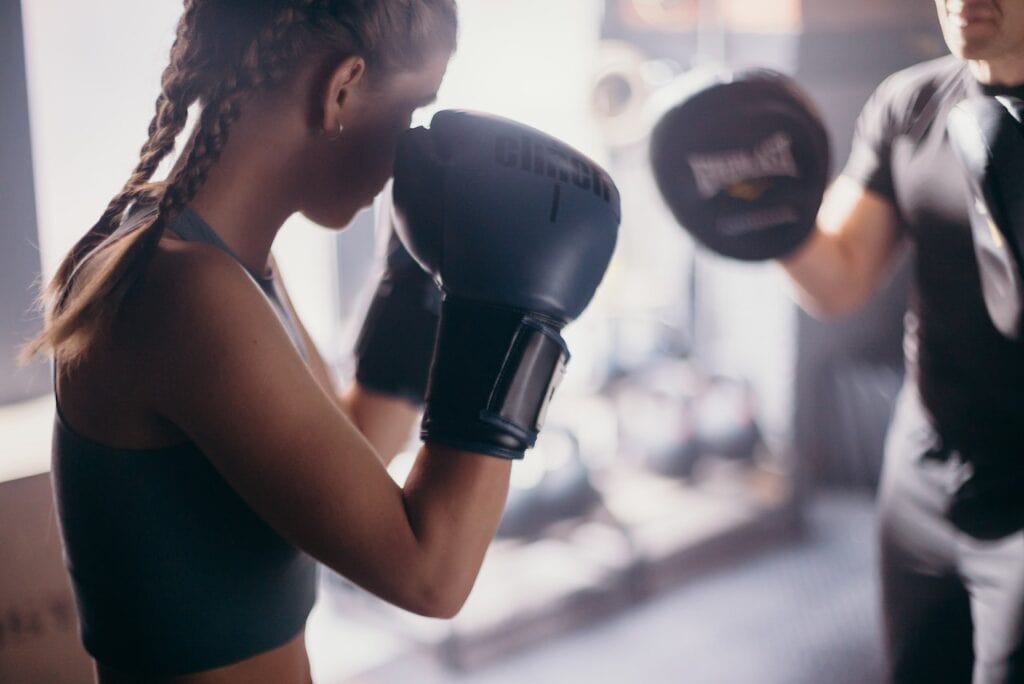
Round 1 Strength: Boxer Push-up
- A. To begin, assume the plank posture with your hands positioned just below your shoulders and your core engaged.
- B. Lower the body until the chest is only a few inches above the floor and hold this position.
- C. Press yourself up to the halfway point, then slowly lower yourself until you hover above the ground.
- D. Perform a full press-up to return to the full plank position. There is one rep for you. (Note: Ensure that you keep the correct form throughout the action by ensuring that your hips do not sag and that your back does not arch.) If you find it too difficult, get down on your knees.)
Carry out ten repetitions.
Round 2 Combo: Double Jab, Cross, Slip-Slip
- A. Start in a guard stance with your arms at your sides and your left foot in front. To throw a double jab with your left arm rapidly, perform two consecutive jabs. After that, follow up with a single jab to the left while throwing a cross punch to the right.
- B. Immediately "slide" by rotating the upper body (keeping the hips steady) and bringing the left elbow near the belly button to avoid an opponent's punches (visualise trying to avoid being punched by an opponent). Right away, you need to reverse direction to the right (the pace of this move is very quick, try counting "1, 2, 3" while doing it to keep the tempo up). Then, bring yourself back to the starting position. There is one rep for you.
Perform ten repetitions as rapidly as possible, swap stances and perform the exercise on the opposite side.
Round 2 Strength: Boxer Push-Up
- A. To begin, assume the plank posture with your hands positioned just below your shoulders and your core engaged.
- B. Lower the body until the chest is only a few inches above the floor and hold this position.
- C. Press yourself up until you are halfway, then slowly lower yourself until you hover above the floor.
- D. Perform a full press-up to return to the full plank position. There is one rep for you. (Note: Ensure that you keep the correct form throughout the action by ensuring that your hips do not sag and that your back does not arch.) If you find it too difficult, get down on your knees.)
Carry out ten repetitions.
Round 3 Combo: Jab, Cross, Hook, Bob and Weave
- A. Stand with your left foot forward and your arms at your sides. Follow up with a left hook after throwing a right cross and a left jab. To add power to the hook, maintain a 90-degree bend in your elbow, pivot your left heel upward, and rotate your left hip forward. (Picture your fist circling the opponent's side of the face while you read this.)
- B. Bring the arms back to the guard position, quickly bob, and weave from right to left, lowering into a squat while simultaneously circling the torso from behind to in front. Get back to the beginning. There is one rep for you.
Perform ten repetitions in a row as rapidly as possible, and then swap your stance before performing the exercise again on the opposite side.
Round 3 Strength: Bicycle Crunches
- A. Lie on your back with your knees bent and your feet flat on the floor. Place your hands behind your head and keep your elbows open.
- B. Lift your head, shoulders, and upper back off the ground, and then perform a bicycle crunch by rotating your left shoulder toward your right knee while keeping your left leg extended straight and parallel to the ground (but not touching it).
- C. Do the same thing on the opposite side. There is one rep for you. Continue alternating while keeping your chin in toward your chest and your belly button tucked in tight to your spine to avoid straining your neck. Keep your hands behind your head at all times.
Perform 20 repetitions in a row at your fastest possible pace.
Round 4 Combo: Jab, Cross, Upper, Slip Front
- A. Start in a guard stance with your arms at your sides and your left foot in front. After throwing a left jab, a right cross punch, and then a left uppercut (by bringing the left elbow into the body, rotating the right hip and heel, and imagining punching up and under the chin of an opponent), throw a left uppercut.
- B. Once you've got that under control, immediately slip forward by rotating your upper body and elbows toward your left knee. Get back to the beginning. There is one rep for you.
Perform ten repetitions in a row as rapidly as possible, and then swap your stance before performing the exercise again on the opposite side.
Round 4 Strength: Bicycle Crunches
- A. Lie on your back with your knees bent and your feet flat on the floor. Place your hands behind your head and keep your elbows open.
- B. Lift your head, shoulders, and upper back off the ground, and then perform a bicycle crunch by rotating your left shoulder toward your right knee while keeping your left leg extended straight and parallel to the ground (but not touching it).
- C. Do the same thing on the opposite side. There is one rep for you. Continue alternating while keeping your chin in toward your chest and your belly button tucked in tight to your spine to avoid straining your neck. Keep your hands behind your head at all times.
Perform 20 repetitions in a row at your fastest possible pace.
Cardio Finisher: Jump Rope Shuffle
Grab your jump rope — whether actual or in your head — and jump from one foot to the other for five minutes to end this at-home boxing workout on a powerful note and burn off any excess energy you may have.
- A. Start by standing with your feet hip-width apart and grasping one handle of a jump rope in each hand.
- B. Bring the jump rope up and over your head to get started. Hop on one foot at a time while alternatingly tapping the other foot out. Always keep your shoulder blades down and back, and use your wrists, not your arms, to rotate the rope.
Jump for between three and five minutes. Then, to conclude, take some time to relax with some of these energetic stretches.
Conclusion
You are not required to sign up for a membership at a boxing gym to learn the sport. It is undoubtedly possible to learn boxing at home, and the process is made much simpler by the abundance of training resources and currently available mediums. Becoming skilled at anything requires an investment of time and regular practice.
When the obstacles are gone, there is a greater chance that we will commit to anything. However, even if learning boxing at home eliminates many of the challenges we experience, we will still need focus and perseverance to be successful.
However, if you consistently engage in daily practice and devour anything boxing-related that comes your way, you will soon be a proficient self-taught fighter.
If you maintain learning and improving by engaging in daily practice and devouring anything boxing-related that comes your way.
Frequenly Asked Questions
Can I learn boxing at home without a trainer?
While having a trainer is beneficial for learning boxing, it is possible to start learning the basics at home. Utilize online resources such as instructional videos, tutorials, and virtual training programs designed for beginners. Focus on mastering the fundamental techniques, footwork, and conditioning exercises. However, as you progress, it's advisable to seek guidance from a qualified trainer to refine your skills, ensure proper form, and advance to more advanced levels.
How often should I train to become a better boxer at home?
Consistency is key when training to become a better boxer. Aim for a balanced routine that includes both skill development and physical conditioning. Ideally, train for at least 3-4 days a week, dedicating around 1-2 hours per session. However, listen to your body and adjust the frequency and intensity of your training based on your fitness level and recovery capabilities.
What equipment do I need to box at home?
To box at home as a beginner, you'll need a few essential pieces of equipment. These include:
-
- Boxing gloves: Choose gloves that fit your hand size and provide adequate protection.
- Hand wraps: Wrap your hands to support and protect your wrists and knuckles.
- Punching bag: A heavy bag or a freestanding bag is ideal for practising your punches.
- Jump rope: Use a jump rope to improve your footwork, endurance, and agility.
- Mirror: Having a mirror nearby helps you observe and correct your form and technique.
- Optional: You may also consider getting focus pads or a speed bag for more advanced training.
What are some basic boxing techniques for beginners?
Here are a few fundamental boxing techniques that beginners can focus on:
-
- Jab: The jab is a straight punch thrown with your lead hand. It's quick and versatile, used for both offence and defence.
- Cross: The cross is a straight punch thrown with your rear hand. Rotate your hips and shoulders for maximum power.
- Hook: A hook is a semi-circular punch thrown with a bent arm. It targets the sides of your opponent's head or body.
- Uppercut: An uppercut is an upward punch thrown from a crouched position. It aims to connect with your opponent's chin.
- Footwork: Work on your footwork to maintain balance, move in and out of range, and pivot for better angles.
How do I develop my punching power at home?
Developing punching power requires a combination of technique, strength, and explosive power. Here are a few exercises you can do at home:
-
- Shadowboxing with resistance bands: Attach resistance bands to a sturdy anchor and practice your punches while overcoming the resistance. This helps build power and speed.
- Plyometric exercises: Incorporate explosive exercises like plyometric push-ups, medicine ball slams, and squat jumps to improve overall power and explosiveness.
- Core strength training: A strong core is essential for generating power. Include exercises such as planks, Russian twists, and medicine ball throws to strengthen your core muscles.
- Practice proper technique: Focus on maximizing your rotational force by utilizing proper hip and shoulder rotation while throwing punches. This will help optimize your power output.
